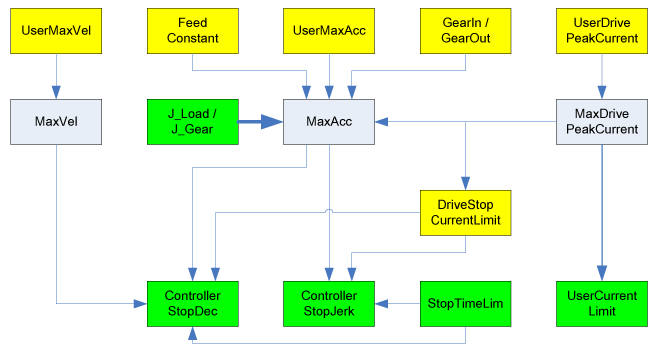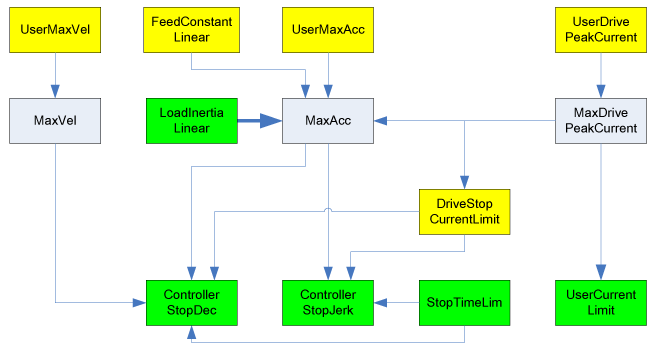|
Type |
AK |
|
Devices supporting the parameter |
Lexium LXM52 Drive, Lexium LXM52 Linear Drive, Lexium LXM62 Drive, Lexium LXM62 Linear Drive, Lexium ILM62 Drive Module, Sercos Drive |
|
Traceable |
No |
The parameter represents the maximum drive speed on the drive shaft (gear box outside). The default value of the parameter MaxVel [units/seconds] equates to UserMaxVel = 0 the rated speed NominalSpeed [RPM]. If UserMaxVel > 0, then MaxVel is set to this value.
With real axes, MaxVel cannot become greater than the value that corresponds to the maximum motor rotational speed MaxSpeed [RPM].
If by virtual axes UserMaxVel is unequal to zero, then this value is taken over in MaxVel. Therefore, the value of UserMaxVel is also taken over if it is greater than the default value (by UserMaxVel = 0).
If a motor has MaxSpeed < NominalSpeed (for example, because of a too low encoder rotational speed), then the motor cannot be operated with the rated speed. In this case, the default value of MaxVel [units/seconds] is the velocity of MaxSpeed [RPM].
NOTE: The parameter value is transferred from the slave to the master via the parameter channel of the Sercos by every access. Typically, this takes about 10 ms. However, up to 1 s can be realized if large amounts of data are transferred on the parameter channel. If the Sercos bus is in phase 0 or 1, then a default value is indicated here. If the Sercos bus is in phase 3 or 4, then the parameter value is transferred and indicated. In the Sercos phase 2, the parameter can be read through the application.
Characteristics of Asynchronous Motors
With asynchronous motors, the rated speed is parameterized by default in MaxVel. By the Voltage/Frequency control this leads to a situation that the rated speed is not being reached because the maximum stator frequency is defined with MaxVel without taking into account the slip. To reach the rated speed by rated torque, the UserMaxVel has to be parameterized with the idle running speed. The maximum speed is not monitored by asynchronous motors without encoder (in open-loop V / f control mode, ControlMode = open-loop control / 1).
NOTE: The default value of MaxVel is the nominal speed of the motor. For a different maximum velocity, use the UserMaxVel parameter to modify the MaxVel parameter. In any case, the MaxVel parameter is limited by firmware to 90% of the maximum speed of the motor.
When operating with third-party motors, it must be understood that the drive can only generate a limited electric frequency.
The resulting maximum speed depends on the PowerStageFrequency and can be calculated as follows:
|
Formula |
Condition |
|---|---|
|
speedmax= 96000 (rpm) / pair of poles |
At PowerStageFrequency 8 kHz or 16 kHz |
|
speedmax= 48000 (rpm) / pair of poles |
At PowerStageFrequency 4 kHz |
If this speed of rotation is exceeded, an impairment of the motor can occur. In the case of multi-pole motors (for example, torque motors), this limit can be reached at relatively low speeds. Motors that can reach a higher maximum speed may only be operated to the limit specified here. The maximum velocity can be limited using the parameter UserMaxVel.
The following graphic indicates the dependency with other object parameters for rotary drives:

The following graphic indicates the dependency with other object parameters for linear drives:

Yellow parameters are input parameters, whose values are taken into account by the Sercos phase up. Green parameters are input parameters, whose values are taken into account immediately. Gray parameters are output parameters. Thick arrows show that a parameter makes an impact on another parameter immediately by the input. Thin arrows show that a parameter does not have an impact until the next Sercos phase up or when the dependent parameter is entered. The arrow indicates the effective direction of the dependency.
Example:
Entering J_Load has a direct impact on the parameter MaxAcc. A revision of MaxAcc only has an impact on ControllerStopDec if,
oa Sercos phase up takes place or
othe parameter ControllerStopDec is modified.